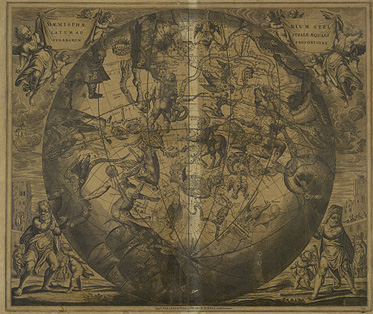Hmisphrium stellatum australe quali sphrarum proportione (The southern stellar hemisphere with equally proportioned celestial and terrestrial spheres)
Andreas Cellarius
Amsterdam: P. Schenk & G. Valk, 1708
Engraving
From the collection of the University of Michigan Map Library
Although little is known about the life of Andreas Cellarius (born around 1596), his work Atlas Coelestis, seu Harmonia Macrocosmica is well known among collectors of celestial maps for the sumptuous Baroque style of its 29 plates. The first 21 constitute a historical survey of cosmological theories, illustrating the motions of the sun and planets according to Ptolemy, Copernicus and Tycho Brahe. The last eight plates are celestial hemispheres and planispheres depicting the constellations; they are the most ornate of all, and their level of artistic detail has made these plates popular among collectors of fine art.
This plate, a perspective view of the constellations of the southern hemisphere, appears to have been detached from a copy of the 1708 reprint of the Harmonia Macrocosmica (it is Plate 29, the last one in the atlas.) Cellarius here employs his innovative technique of “scenography,” common to several of the Harmonia Macrocosmica’s celestial maps, in which he depicts the constellations on the surface of a translucent sphere through which we can glimpse portions of the Earth: The Pacific Ocean, South America, the Carribean Sea, part of North America and the “great unknown South Land” (Terra Australis Incognita). Along with seven signs of the zodiac and 23 Ptolemaic constellations, Cellarius includes twelve new Southern constellations described by Petrus Plancius in the late sixteenth century: The Southern Triangle, the Peacock, the Indian, the Crane, the Phoenix, the Toucan, the Lesser Water Snake, the Goldfish, the Flying Fish, the Chameleon, the Fly, and the Bird of Paradise.1
The ornamentation that surrounds the map depicts a scene from the ancient world, and contains mythological references:
The celestial sphere is supported by the titan Atlas (lower left) and by the Greek hero Hercules, draped in a lion skin and with his club at his feet (lower right). The scene refers to the eleventh of the Twelve Labours of Hercules: Tasked with bringing back the golden apples from the garden of the Hesperides, Hercules approached Atlas for help. Atlas agreed to get the apples if Hercules would temporarily step in to hold up the heavens, which Atlas had been condemned to carry as punishment for taking part in the revolt of the Titans against the Olympian gods. It was Atlas’ intention to leave Hercules shouldering the sky after he had stolen the apples, but Hercules tricked him into resuming his wearisome burden.2
While perhaps not the best specimen (see the Atlases & Charts section for clearer images), this map is included because of its interesting history, which illustrates the role of the Harmonia Macrocosmica in popular culture. A gift of Kathryn Van Leeuwen which entered the Map Library’s collection in 2004, it was purchased at auction after hanging for many years in the offices of the Sanders Candy Company — a Detroit, Michigan institution since 1875. This is characteristic of the Harmonia Macrocosmica’s role as a touchstone of classical culture in modern society. As Nick Kanas remarks in his account of the Harmonia Macrocosmica, “Rarely have the art and science of celestial images been more beautifully depicted, which has accounted for the great popularity of these plates today in interior decorator offices and corporate boardrooms.”3
The Harmonia Macrocosmica marks a high point in the artistic development of celestial maps, but it was based largely on existing work and contributed no new science. The perfection of the telescope would soon force artistic considerations to take a back seat to accuracy: Although the beauty of Cellarius’ atlas has rarely been surpassed it was quickly superseded by homelier but more accurate maps.
1 Van Gent 197.
2 Van Gent 179.
3 Kanas 193-194.






